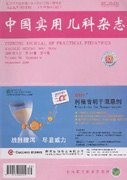|
Clinical analysis of typhoid fever in 56 children and risk factors for its complications
TANG Yan*,JIANG Hui,ZHAN Xue
2020, 35(10):
796-801.
DOI: 10.19538/j.ek2020100613
Objective To investigate the clinical characteristics and the risk factors forcomplications of typhoid fever(TF) in children. Methods The clinical data of 56 TF children diagnosed in our hospital from 2009 to 2018 were reviewed. The analysis of related factors of complications by logistic regression,estimating the relativity between age,platelet count at admission and number of complications by Spearman rank correlation. Results The symptoms of typhoid fever(TF) in children were atypical. The time from onset to diagnosis of typhoid fever was (12.0±8.3) days. In most children with diarrhea,the diarrhea often occurred within 1-5 days after fever. The positive rates of bacterial culture were 63.8% in blood culture,41.7% in bone marrow culture and 39.0% in fecal culture,and the positive rate of different disease period was different. However,the positive rate of Widal’s test was only 8.8%. Eosinophil count decreased in 73.8% and disappeared in 40.5%of the children. Children with typhoid fever were prone to electrolyte disorders(hyponatremia,hypokalemia and hypocalcaemia),especially in children aged less than 3 years. About 12.2% of the positive cases showed multidrug resistance. The sensitivity of clinical isolates to ceftazidime,cefepime,ceftriaxone,cefotaxime,ciprofloxacin and levofloxacin showed no significant change compared with that in 1993-2008. Complications occurred in 78.9%(71.7%-86.1%) of children with TF. Thrombocytopenia and the age of the child were associated with TF complications,and the degree of thrombocytopenia and age were also related to the number of complications. Conclusion Clinical manifestations of TF in children are not typical. The time from onset to diagnosis of typhoid fever was relatively long,so it’s likely to be misdiagnosed. In most children with diarrhea,the diarrhea often occurred within 1-5 days after fever. The positive rate of blood culture was the highest. For culture-negative individuals,Widal test and eosinophil counts may be useful in the diagnosis of TF. In the recent 20 years the clinical isolates are still sensitive to the third generation of cephalosporin and quinolones. Children with TF are prone to complications,and children with thrombocytopenia or older age are more prone to these complications and also more prone to multiple complications.
|

